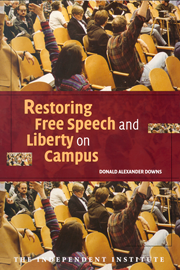Free-speech controversy is riveting higher education again. Major schools recently dis-invited graduation speakers whom activists deemed “improper” to their notions of justice. And many institutions have begun formally to institute—or consider instituting—“trigger warnings.”
“Trigger warnings” are verbal or written warnings instructors provide about material that might trigger “trauma” in students who have experienced or witnessed traumatic events, including forms of assault and war, and are sensitive about such topics as race, gender, sexual orientation, colonialism and imperialism—to name a few.
The humane case for trigger warnings is that they allegedly help protect students from re-experiencing the past trauma, which can emotionally harm the student and interfere with his or her ability to learn.
What could be wrong with that? Warnings might make outright censorship less likely, much like the movie industry avoided government censorship by agreeing to use ratings labels for films. This could even enhance freedom of inquiry while protecting emotional wellbeing. And have not many instructors quietly and informally engaged in such practice in the past?
Alas, many substantial problems lurk just beneath the surface—especially when one considers the intellectual climate at many colleges and universities, of which the fate of recent graduation speakers is symptomatic. Let me touch on a few.
First, as critics from across the political spectrum have averred, it is impossible to determine in advance what material merits a warning. To avoid complaints, threats and possible lawsuits because they failed to warn of some potentially offensive material, many instructors, given the general pressures at play in higher education, would likely extend warnings to large amounts of material, sending the misguided message that learning is traumatic per se.
Or they could bowdlerize the course material in the name of sensitivity. If ever the concept of the slippery slope applied, it would apply here.
Already, trigger warnings have been applied to such works as “The Great Gatsby,” “The Merchant of Venice” and other classics.
“Gatsby?” Really?! What’s next? “Hamlet?” And what if a student refuses to read the flagged material, however important it is to the class? Do not trigger warnings imply the right of refusal, which would open yet another Pandora’s Box?
Another danger waits: formalizing trigger warnings would further empower the higher-ed sensitivity bureaucracies that are often as voracious and omnipresent as they are ignorant of basic academic freedom principles.
Most important, the rationale for formal trigger warnings is inimical to the purposes of education.
Liberal education should expose students to the depths of the human condition, which unavoidably entails matters of good and evil, life and death—what the German philosopher Nietzsche called “uncomfortable truths.”
And civic education must prepare students to be mentally strong enough to handle the rigors associated with the clash of ideas that is paramount to a free society. As the great educational philosopher Alexander Meiklejohn remarked, “To be afraid of ideas, any idea, is to be unfit for self-government.”
Born from the tenets of the controversial “trauma movement” in psychology, trigger warnings assume that many students are not capable of handling the responsibilities of adult citizenship.
In the name of sensitivity, the movement undermines the very equal respect it ostensibly supports, while also fostering the mentality of in loco parentis that universities properly abandoned decades ago.
To deal with occasional cases of extreme material, leave the matter where it has always resided: at the considered informal discretion of instructors.
If a formal trigger warning must be had, place these words atop a university’s main webpage: “Education necessarily exposes students to ideas and experiences that are new, challenging, and sometimes painful. To be properly educated, you must learn to handle and welcome such challenges.”








